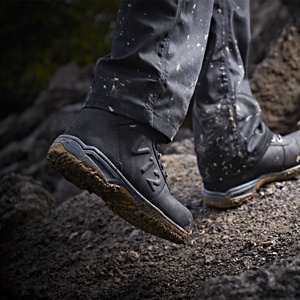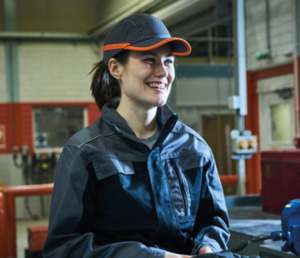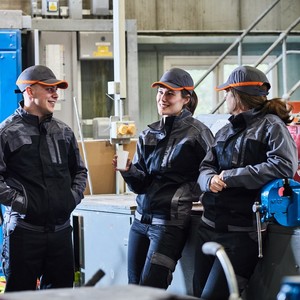
 |
Mark Sennett
Managing Editor |
 |
Kelly Rose
Editor |
| Home> | PPE | >Safety Footwear | >Taking comfort in safety |
Taking comfort in safety
27 February 2024
WHEN THINKING about safety footwear, it’s easy to assume that the protective features are the most important aspect, and that comfort is secondary.

But anyone who’s ever had to work long hours with foot pain, strain, cramp or blisters from poor fitting footwear will tell you that comfort isn’t second in the queue – it's very much a part of safety.
Comfortable PPE allows wearers to focus on the job and the surrounding hazards, avoid long-term musculoskeletal issues such as joint misalignment, plus reap the benefits of the huge positive impact on wellbeing good comfort brings. That sounds a lot like good health and safety to me.
Unfortunately, many wearers still aren’t being given access to the comfort they require and deserve - and having to endure poorly-fitting PPE will be particularly resonant for women work boot wearers.
A brief history of poor PPE provision
The female foot is anatomically different from a man's, and not just smaller on average in size. Compared to men’s, women’s feet have a smaller Achilles tendon, higher arches, a lower instep and a more curved inside line.
However, this has all too often not been reflected in the safety footwear issued to women across multiple industries. Instead, many have had to make-do with wearing smaller men’s boots - but because men’s feet are shaped differently, so are the boots, and therefore don’t reflect or contour the female foot inside them.
Women who have had to or continue to endure wearing men's safety footwear can suffer a range of serious and long-lasting foot problems including:
- Blisters
- Corns and calluses
- Plantar Fasciitis
- Joint misalignment
- Hip and back pain
And if you think that’s an exhaustive list – think again. Women wearing ill-fitting men’s footwear also experience pelvis and thigh strain from clenching their toes to stop boots that are too wide from slipping, as well as hot feet due to resorting to wearing multiple socks to solve the same problem - which can also worsen diabetic neuropathy.
Finally, incorrectly sized boots mean incorrectly positioned protective features, so in the event of a heavy impact, components such as toecaps, ankle padding and metatarsal guards may be in entirely the wrong place for female wearers.
Designed for women?
To make matters more complex for women trying to find comfort at work, the term ‘female fit’ to describe safety boots isn’t always as straightforward as it sounds.
‘Pink it and shrink it’
A significant amount of footwear currently on the market is labelled as ‘female-fit,’ but often fails to reflect this in its design. Sometimes referred to as the ‘pink it and shrink it’ method, this type of footwear is essentially men's footwear, built on a men’s last, but with smaller sizes available and the aesthetics changed to a more ‘feminine’ design to give the impression they are made for women. The problem here is that this type of product can cause largely the same issues that men’s footwear creates when worn on a women’s foot.
Nominal
Nominal female footwear is better than the 'pink it and shrink it' variety, as this is developed with a women's last - the problem is that it's often made with good intentions, rather than a bespoke design.
Because many think a women's foot shape is simply narrower than a man’s, this type of footwear is often made with a last that's sanded down to reduce the width. A small improvement for women wearers, yes, but because the other anatomical nuances of the female foot aren’t reflected in the design, it will often not give the wearer appropriate fit, so the chances of discomfort remain high.
True women's fit
Thankfully, some safety footwear manufacturers understand the link between comfort and safety for the millions of females working in safety industries across the UK.
When safety footwear manufacturer V12 Footwear developed their female and men’s fit safety ranges, they took a data-driven approach to reflect the differences in design. They used over 4,000 scans of foot shapes to build a last (the foot form around which a boot is built) which provided footwear that specifically contours and supports the feet of women and men in their respective ranges. Furthermore, because the scans used were of global foot shapes, footwear in their female range also accommodates both the narrower feet of Eastern nations such as China as well as the wider European fit. And that’s True Women’s Fit.
Building on the fundamentals
Only when the fit is correct, and the foot shape and size is accommodated should procurers and wearers be looking for additional comfort features. A wearer could have padding and cushioning overflowing from their boots, but, if the fit isn’t right, these additional elements will not do the job. And lack of comfort is distracting – and there’s nothing more unsafe than a distracted worker in a safety critical environment.
V12 Footwear are one of the manufacturers who’ve taken an innovative approach to supply their wearers with enhanced comfort features, exploring materials, weight and design to get comfort and elevate it to the absolute maximum for both their female and male wearers.
Less is more
To stay safe is to stay focussed, and for this to happen, it’s vital wearers have footwear that eliminates discomfort. And often, to achieve this it’s the smaller details that can really be effective. Take V12 Footwear’s approach to wearer comfort while driving and working at height. Many of their styles are designed with a lowered or ‘cut-away’ collar for the back of the ankle. This ensures the wearer’s Achilles is protected and supported, but this scooped collar means that when driving or climbing up or down ladders, there is no rubbing or chaffing on the lower leg. Small detail, big difference.
Shock-absorption
The average safety boot wearer walks up to seven miles a day, while warehouse pickers can take 22,000 steps per shift – which over 10 miles. For wearers notching up this many steps in a day, often on hard floors, shock-absorbance is key. But V12 give it to their wearers in abundance. With a shock-absorbing PU insole as well as an EVA midlayer, wearers' feet are cushioned and supported on every step, and to take comfort innovation to the highest level, pop in a pair of their Dynamic Arch insoles with open-cell rebound foam, and wearers get cloud-like comfort.
Safety first?
The phrase ‘safety first’ is one we all know well – but perhaps it’s time to rethink this. Perhaps the key to comfort for both women and men working in their safety boots for eight hours plus a day is remembering that comfort - through the right fit and design - comes first, and only then will true safety follow.
For more information, visit www.v12footwear.com


























